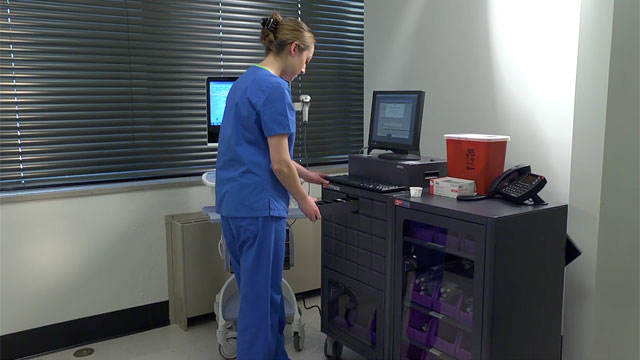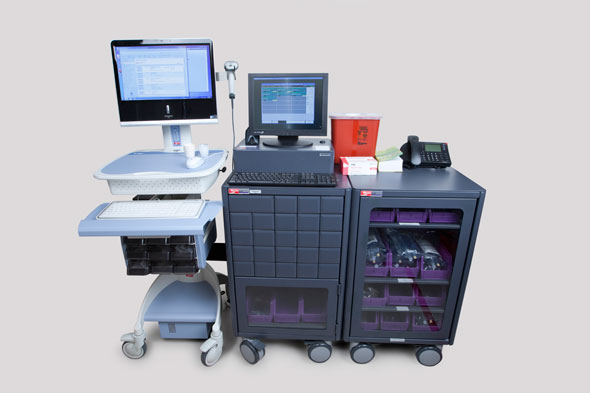Safe Medication Administration
Select a Skill:
- » Ensuring The Six Rights of Medication Administration
- » Administering Oral Medications
- » Documenting Medication Administration
- » Handling Medication Variations
- » Preventing Medication Errors
- » Using Automated Medication Dispensing Systems
Take the Review Test:

Safety
- Keep medication storage areas locked when unattended.
- Use of an automated medication dispensing system may reduce the incidence of medication errors.
- Use of bar codes improves the accuracy of patient identification, reduces the incidence of medication errors, and improves medical record keeping. Always compare the medication provided to the medication administration record (MAR), the prescriber's order, or both because no medication dispensing system is foolproof.
- Prepare medications for one patient at a time.
- Minimize distractions and interruptions while preparing medication, including questions from staff and family, equipment alarms, and personal conversations. Never share your automated medication dispensing unit security code or password.
-
Remember to sign out of the automated medication dispensing system when finished.
Equipment
(Roll cursor over items to see labels)

Medication unit-dose cart
Medication administration record (MAR)
Delegation
The skill of using medication dispensing systems may not be delegated to nursing assistive personnel (NAP).
Preparation
- If possible, prepare medications in an area designed for that purpose or at a unit-dose cart.
- Perform hand hygiene. Ensure that medication preparation surfaces are clean.
- Minimize distractions and interruptions during medication preparation, close the door of the medication room, and do not try to perform other tasks while preparing a medication.
- Double check all calculations and other high-risk medication administration processes (e.g., patient controlled analgesia) and verify with another nurse.
- Review any preadministration assessments (e.g., vital signs, review of laboratory results).
-
Keep tablets and capsules in their wrappers and open them at the patient’s bedside. This allows you to review each medication with the patient. If a patient refuses medication, there will be no question which one was withheld.
Follow-up
- Log out of the medication dispensing system properly, and keep medication storage areas locked when unattended.
- Stay alert for medication errors, drug incompatibilities, and medication allergies.
-
Verify all medications dispensed for the correct dose and route. Report any discrepancy between what the physician ordered or what was requested from the dispensing system and what was supplied.
Documentation
- Record the name of the medication, the actual time of administration, the dose, and the route on the MAR immediately after administration. Include your initials or signature. Do not chart medication administration until after the drug is given to the patient. (For details, see "Documenting Medication Administration.")
- It is not necessary to document use of a medication dispensing system separately.
- Document any medication dispensing discrepancy according to facility policy. It is not necessary to record the discrepancy in the patient's medical record if the medication was not administered.
Review Questions
1. What is the nurse’s first step in preparing to administer a prescribed medication using an automated medication dispensing system?
 Establish the patient’s ID using two identifiers
Establish the patient’s ID using two identifiers Review the medication administration record (MAR)
Review the medication administration record (MAR)  Provide patient education
Provide patient education Review applicable nursing considerations
Review applicable nursing considerations
2. Which precaution should the nurse observe to ensure patient safety when using an automated medication dispensing system?
 Assess the patient's ability to swallow oral medications without difficulty
Assess the patient's ability to swallow oral medications without difficulty Ask the patient about his or her experience with this or similar medications
Ask the patient about his or her experience with this or similar medications Prepare medications for one patient at a time
Prepare medications for one patient at a time Evaluate the patient's understanding of the safety issues related to the specific drug
Evaluate the patient's understanding of the safety issues related to the specific drug
3. Which statement or question best illustrates the nurse’s understanding of the role of nursing assistive personnel (NAP) in using medication dispensing systems?
 "Does the patient need her pain medication?"
"Does the patient need her pain medication?" "Let me know if she complains of any nausea."
"Let me know if she complains of any nausea." “Ask her to describe her pain and show you where it is."
“Ask her to describe her pain and show you where it is." "Remember to log off of the system when you are finished."
"Remember to log off of the system when you are finished."
4. Which action by a nurse is most important in protecting the safety of patients and staff when using an automated medication dispensing system?
 Refusing to share his or her individual security log-in code for the dispensing system
Refusing to share his or her individual security log-in code for the dispensing system Having another registered nurse check his or her mathematical calculations
Having another registered nurse check his or her mathematical calculations Reviewing a current drug book for dosing information
Reviewing a current drug book for dosing information Using two different mathematical formulas to cross-check a dosage calculation
Using two different mathematical formulas to cross-check a dosage calculation
5. While preparing a patient's oral medication dispensed from an automatic system, the nurse realizes that the pill dispensed is twice the required dose. What is the nurse’s best response?
 Notify the health care provider and ask if the higher dose could be given
Notify the health care provider and ask if the higher dose could be given  Access the dispenser again for the appropriate dose
Access the dispenser again for the appropriate dose  Notify the pharmacy to determine if the accurate dose is available
Notify the pharmacy to determine if the accurate dose is available  Splitting the pill in half
Splitting the pill in half
You have completed the Review Questions for this skill. To take the Review again select the Start Over button. To proceed to another skill select from the dropdown menu. Select the Home or Back button to proceed to the next section.

